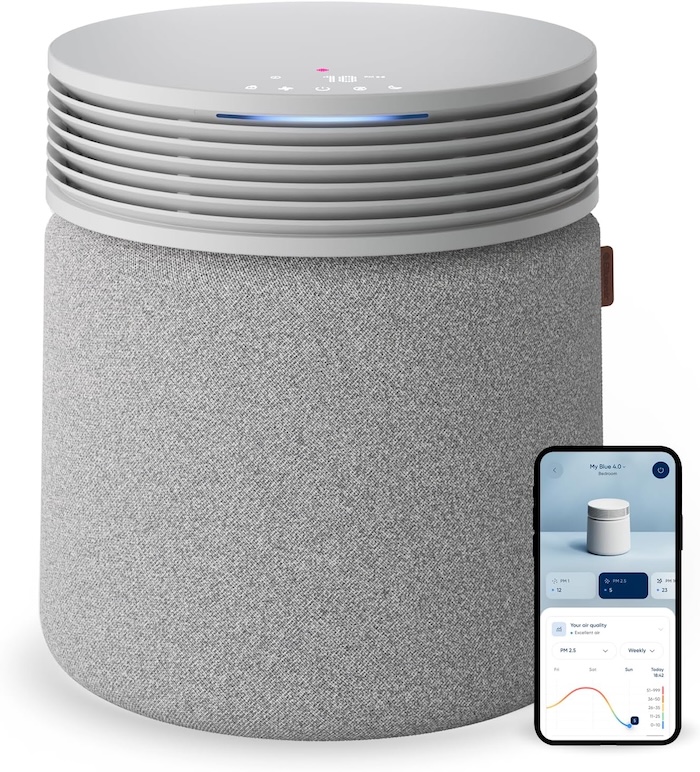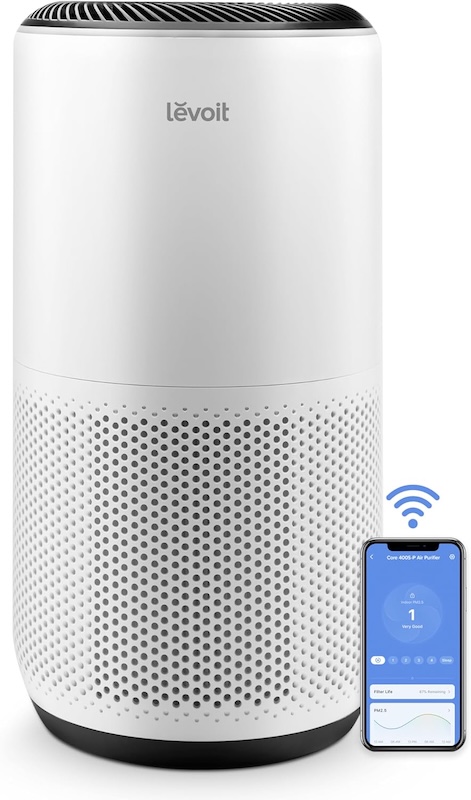When you’re shopping for a new air purifier, comparing one unit to another can be tricky. Beyond brand and price, you’ll want to consider factors like filtration type, compatible room size, and extra features. One of the most effective ways to objectively compare models is by checking their Clean Air Delivery Rate, or CADR, ratings.
CADR ratings were developed by the Association of Home Appliance Manufacturers (AHAM) to validate the volume of filtered air (measured in cubic feet per minute, or CFM) a purifier delivers for specific particle sizes, including smoke, dust, and pollen. Each particle size rating represents everyday pollutants: smoke for very fine particles, dust for medium-sized, and pollen for the largest. Since CADR scores are based on standardized testing and given separately for each particle type, they can help you select a model that best matches your needs.
As simple as that all may seem, not every manufacturer participates in testing or publishes CADR information, and some provide either a range of scores or a single composite score instead of three separate and specific ones. To choose an air purifier that aligns with the pollutants that are causing you the most problems, it makes sense to look for one with comprehensive CADR data.
What is a CADR rating?
A CADR is a reflection of an air purifier’s airflow rate and efficiency at removing various-sized particles. CADR ratings are given for smoke (very fine particles 0.09 to 1 micron in size), dust (medium particles between 0.5 and 3 microns), and pollen (large particles sized 5 to 11 microns), with a higher CADR number corresponding to faster air cleaning. For dust, the highest possible CADR value is 400, and for smoke and pollen, the value tops out at about 450.
To find the best air purifier for your needs, look for one with a high rating in the category that matters to you most. For example, if you suffer from allergies, a unit with CADRs of 250 for pollen, 234 for dust, and 220 for smoke will be a better fit than one with ratings of 210 for pollen, 266 for dust, and 250 for smoke.
Before the development of CADR ratings, companies typically listed CFM ratings as a measure of a purifier’s capacity. However, because CADR ratings reflect both the volume of air a unit can process and a filter’s effectiveness at removing specific airborne particles, they are better indicators of effectiveness than CFM, which only illustrates how much air a unit can move.
How are CADR ratings calculated?
To calculate a purifier’s CADR ratings, testers place it in a sealed 10.5-foot by 12-foot chamber with an 8-foot ceiling (1,008 cubic feet in volume). The purifier unit must be 29.25 inches from the floor, and the room must be at a temperature of 70 degrees Fahrenheit with a humidity level of 40 percent.
Researchers introduce smoke, dust, and pollen into the chamber, noting the particle count of each. They monitor how many smoke, dust, and pollen particles are removed with the unit on at full speed compared to off entirely, then multiply that difference by the size of the room. The resulting CADR rates represent the volume of clean air in cubic feet per minute the purifier delivers for each pollutant type.
Does room size affect the CADR you need?
Yes, room size affects the CADR you need. An air purifier for smoke with a CADR of 375, for example, might be more than you need for a small bedroom. To find the appropriate CADR rating for your space, look for a CADR value that is approximately two-thirds of the room’s square footage.
Here’s an example. Say you want an air purifier for your 12-foot by 16-foot bedroom to help with sudden house allergies caused by dust, but you don’t know how high a CADR rating you should be looking for: Multiply your room’s length (12 feet) by its width (16 feet) to get its square footage:
12 x 16 = 192 square feet
then multiply that value by 0.66 to get the necessary CADR rating.
192 x 0.67 = 128.64
Since 12 times 16 is 192, and two-thirds of 192 is approximately 128, you’d need a purifier with a CADR for dust of 128 for your room.
Do CADR ratings measure odor removal?
No, CADR ratings do not directly measure odor removal. They focus on the purifier’s ability to get rid of dust, smoke, and pollen rather than how well they remove the gaseous volatile organic compounds (VOCs) that cause odors.
Depending on what’s causing the odor, however, CADR ratings can offer clues regarding its removal. For example, if you’re looking to minimize the smell of smoke caused by a nearby wildfire, a unit with a higher CADR for smoke can suggest better performance in reducing those odor-causing particles. Then, to even more effectively remove the smell of smoke in your home, you could consider a unit with an activated carbon or True HEPA filter that specifically targets odors.
Can a purifier’s CADR rating change?
Yes, a purifier’s CADR ratings can change over time. Because these ratings indicate how effective new air purifiers are at cleaning the air when run on high speed, they gradually become less effective as their filters collect particles over time, resulting in decreased CADR.
Since testing measures each unit’s effectiveness at the highest speed, how well air purifiers work is also affected by the setting they are on. Running a purifier at lower fan speeds reduces its airflow and filtration rate, meaning its performance won’t match its CADR rating.
Air Purifiers We’ve Tested and Recommend
Break out your air quality monitor: According to our tests, these are the best air purifiers for smoke, allergies, mold, and pets.
For Smoke
Thanks to its powerful filtration for smoke in rooms up to 1,748 square feet, the Coway Airmega AP-1512HH Mighty Air Purifier was our top pick in our guide to the tested guide to the best air purifiers for smoke. Not only does it boast a CADR rating of 234 for smoke, it also features an impressive 232 for pollen and 248 for dust, making it an effective all-around performer. It uses a three-stage filtration process with a washable prefilter, a deodorization filter, and a True HEPA filter to remove up to 99.97 percent of particles as small as 0.3 microns from the air. Other notable features include an LED air quality indicator light, auto and eco modes, a timer, and filter replacement indicators.
Get the Coway Airmega AP-1512HH Mighty Air Purifier at Amazon for $206.99.
For Allergies

Blueair’s new Blue Signature air purifier is hot off the testing presses, and it’s one of the most impressive units we’ve ever tried. With CADR ratings of 450 for pollen, 434 for dust, and 455 for smoke (exceeding CADR’s top margin by a bit), it provides exceptional air purification for any pollutant it encounters. The sleek and modern unit uses a single accordion-style filter that’s easy to replace and offers seven stages of filtration to capture 99.97 percent of particles down to 0.1 microns. One of our favorite features of this model is AirSense, which automatically runs two quick cleaning cycles every day to keep allergens at bay. Beyond performance, the Blue Signature also shines in design, with a clean, minimalist look and a motion-sensitive interface that stays hidden until you need it.
Get the Blueair Blue Signature air purifier at Amazon for $411.45.
For Mold

Made to clean the air in a 215 square foot room in 12.5 minutes or a 1,043 square foot room in 60 minutes, the GermGuardian AC3000 AireSafe Intelligent Air Purifier is an excellent option for those seeking an air purifier to eliminate mold and odors. Given our “Best for Sanitizing” award, this model has CADR ratings of 146 for dust, 150 for pollen, and 139 for smoke, a carbon pre-filter, and a 360-degree True HEPA filter to eliminate up to 99.97 percent of pollutants as tiny as 0.1 microns. Thanks to its powerful UV-C light (a rare feature for purifiers at this price point), it also eliminates airborne viruses, bacteria, and mold spores. This model has an air quality indicator light and a very effective auto mode that measures air quality 60 times per minute and adjusts accordingly.
Get the Germ Guardian AC3000 AireSafe Intelligent Air Purifier at Amazon for $109.99.
For Pet Owners

As the top pick in our tested guide to the best air purifiers for pets, the Levoit Core 400S Smart Air Purifier might be an ideal fit for pet owners. It uses a three-stage filtration system to trap 99.97 percent of pollutants as small as 0.3 microns, resulting in CADR ratings of 259 for pollen, 240 for dust, and 231 for smoke. In our tests, it was one of the fastest purifiers for eliminating pet dander and hair shaken out of a vacuum canister, and that was with the included filter. For even better results, Levoit offers a pet allergy filter specially made to capture fur and unpleasant odors. Also, as a smart model, this purifier is easy to control via the onboard touch panel or the free VeSync Link mobile app.
Get the Levoit Core 400S Smart Air Purifier at Amazon for $229.99.
Prices listed here are accurate as of September 22, 2025.



